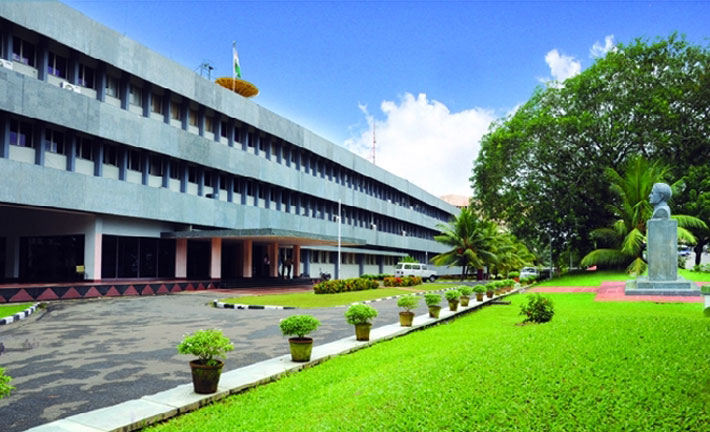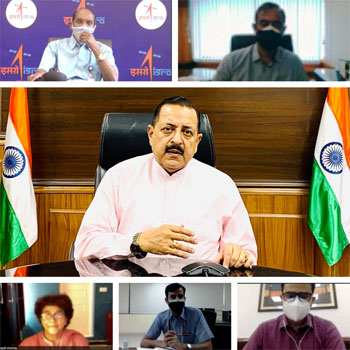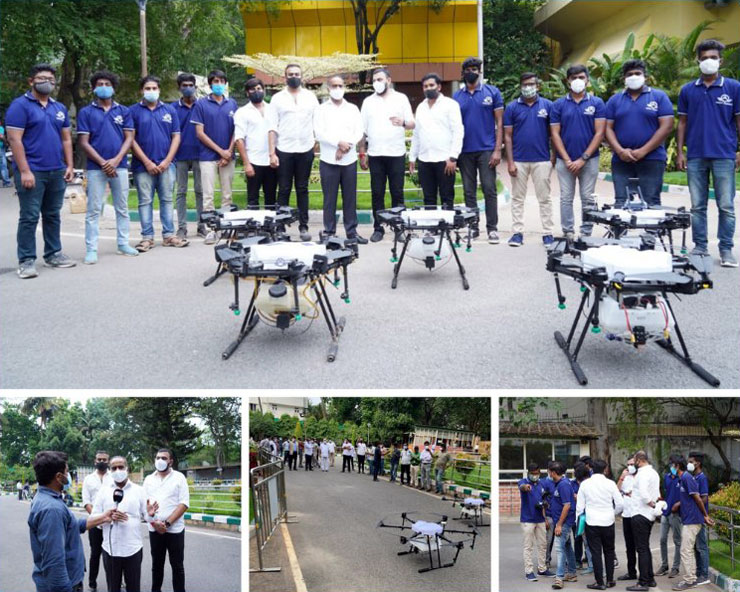INDIAN ARMED FORCES CHIEFS ON
OUR RELENTLESS AND FOCUSED PUBLISHING EFFORTS

SP Guide Publications puts forth a well compiled articulation of issues, pursuits and accomplishments of the Indian Army, over the years

I am confident that SP Guide Publications would continue to inform, inspire and influence.

My compliments to SP Guide Publications for informative and credible reportage on contemporary aerospace issues over the past six decades.
Department of Space offers innovative collaborations to manage the crisis
Three ventilators and an oxygen concentrator have been developed by ISRO’s Vikram Sarabhai Space Centre and are soon expected to be commercially produced.

Dealing with the havoc that the crisis has brought along in the country during the past couple of weeks, innovation and collaboration has been observed with players from various industries contributing in their own ways. The Department of Space (DoS), Government of India has also been active in initiating relevant discussions and steps to curb the virus.
Recently, in a notable feat, the Indian Space Research Organisation’s (ISRO) Vikram Sarabhai Space Centre (VSSC) in Thiruvananthapuram, has developed three different types of ventilators and an oxygen concentrator to help cope with the shortage of these critical medical equipment across the nation.
Technology transfer for the commercial production of these three ventilators and an oxygen concentrator is likely to be done this month itself while the price of these ventilators is said to be around 1 lakh. This makes these ISRO ventilators cost effective as well as easy to handle compared to the conventional ventilators that are mostly priced around 4-5 times this.
Based on the designs, features and specifications, the ventilators have been named as PRANA, VaU and SVASTA. All three are said to be user-friendly, fully automated and with touch-screen specifications, meeting all safety standards and have been checked by doctors and other experts for efficacy.
Based on the designs, features and specifications, the ventilators have been named as PRANA, VaU and SVASTA.
PRANA is short for Programmable Respiratory Assistance for the Needy Aid and is capable of delivering respiratory gas or oxygen-rich air to the patient by automated compression of an AMBU (Artificial Manual Breathing Unit) bag. AMBU bag, also referred to as self-inflating bag, is commonly used to provide positive pressure ventilation to people who are not breathing adequately.
SVASTA stands for Space Ventilator Aided System for Trauma Assistance and is designed to work without electric power. SVASTA is said to operate on compressed air and achieves different modes of ventilation through mechanical settings alone.
The VaU or the Ventilation Assistance Uniton is a low-cost dual-mode ventilator that can work with either medical oxygen from the hospital or with ambient air. What makes it more special is that it has the possibility to be used not just as an ICU ventilator but also as a portable or home ventilation unit.
Apart from the three ventilators, the VSSC has also developed a portable medical oxygen concentrator called Shwaas. “It is capable of supplying 10 litre enriched oxygen per minute, adequate for two patients at a time. It enhances the oxygen gas content by selectively separating the nitrogen gas from ambient air through Pressure Swing Adsorption (PSA) which is commonly used for production of oxygen from air, VSSC Director S. Somanath informed.
Teams of space scientists from multiple disciplines at the ISRO facility had begun working on the ventilator designs last year itself, following the outbreak and took on the challenge last month with the surge in the COVID infections and followed demand for ventilators. The models were unveiled last year and the eventual tests were now taken up.
Apart from the technologies through these devices, ISRO is also providing geospatial tools and location-based solutions including a national-level COVID tracker, ‘Bhuvan-COVID-19’, developed by ISRO’s National Remote Sensing Centre.
Department of Space provides oxygen to states
Union Minister of State, Dr. Jitendra Singh also stated last week that DoS has gone beyond its call to provide COVID related support, mainly liquid oxygen, to states of Tamil Nadu, Kerala, Andhra Pradesh and to Chandigarh.

ISRO Chairman Dr. K. Sivan informed in an online review meeting that 9.5 tonnes of oxygen is being given to Tamil Nadu and Kerala per day, besides that the oxygen capacity of Andhra Pradesh and Chandigarh was augmented. “87 tonnes of liquid oxygen (LOX) manufactured and supplied by ISRO Propulsion Complex, IPRC has already been given to Tamil Nadu and Kerala by ensuring 24x7 work schedule. Moreover, 12 metric tonnes of LOX sent to augment oxygen availability in Andhra Pradesh,” he added, according to a statement released by the department.
The department is also ensuring supply of oxygen cylinders for local public in Andhra Pradesh and Kerala, Singh said, further adding that the manufacturing of advanced medical devices designed by the department including ventilators, Prana, and VaU shall be taken up with industries at the earliest.
The Space Application Centre at Ahmedabad has successfully converted 2 Liquid Nitrogen Tanks of about 1.65 lakh litres into liquid oxygen tanks for storage and supply in Ahmedabad and nearby hospitals. The Minister also informed that oxygen concentrators being procured for dispensaries for use by patients and the design of disinfectant chamber for baggage & new oxygen concentrators is already in progress.
The other technological support provided by the Department includes, COVID vaccination centers mapping across India integrated with Cowin app to help citizen reach the nearest vaccination center, deployment of non-contact thermal camera developed by Space Applications Centre (SAC), development of COVID-19 dashboard in sync with Ministry of Health and Family Welfare (MoHFW) and the development of a mobile app ‘FIGHT CORONA’ in collaboration with ICMR, Dibrugarh, Assam for collection of geotagged information ofCOVID-19 cases in the state of Tripura.
Apart from the three ventilators, the VSSC has also developed a portable medical oxygen concentrator called Shwaas, is capable of supplying 10 litre enriched oxygen per minute.
Singh has also nudged the department to explore the possibility of creating more COVID Care Centres apart from the ones established in Bengaluru, Shillong and Sriharikota.
Apart from contributing to the pandemic relief, the Department of Space is continuing to work on the 10 scheduled satellite launch projects including the unmanned Gaganyaan Mission in December this year.
Drones for sanitisation & deliveries
ISRO recently undertook the trials for drone-based delivery of medicines, vegetables and disinfectant spray at their staff quarters in Sriharikota, using drones from the drone-as-a-service startup, Garuda Aerospace. This was done in as an attempt to reduce physical interaction of the staff with the outside world to minimum and to look at automation as a solution. ISRO is considering complete implementation of the drones after it receives internal approvals from the management.
Garuda Aerospace is a Chennai-based start-up that designs, builds and customises unmanned aerial vehicles or drones for multiple applications. The start-up had deployed 15 ‘White Knight’ drones in Bengaluru as a part of feasibility analysis and field trials starting this month to deliver medicines and vaccines in four hospitals in the Bengaluru Central constituency.

The start-up has developed and manufactured a highly specialised delivery fleet of 30 “White Knight” drones to deliver emergency medical kits, COVID-19 vaccines and medicines as well as carry sanitisation operations across the country.
The White Knight drones are equipped with a temperature controlled module, can carry a payload of 35-40 kg and travel 50-60 km with an endurance capacity of two hours.
The state of Karnataka is aiming to adopt drone technology to deliver COVID-19 vaccines to remote areas, medicines in containment zones and to sanitise the primary health centres in the state. Chief Minister B.S. Yediyurappa launched the drone-based sanitisation of public places and drone delivery of medicines on a trial basis in the city last week.
A taskforce headed by Bengaluru Central Member of Parliament, P.C. Mohan has got Garuda Aerospace on-board to run the pilot project in the city. Garuda Aerospace has been conducting sanitisation operations in different parts of Bengaluru as well as in Tamil Nadu. The start-up also stated earlier this month that their White Knight is ready for deployment for delivering the COVID vaccines.
The Directorate General of Civil Aviation (DGCA) had also conceded a conditional exemption to ICMR (Indian Council of Medical Research) for testing the feasibility of drones in delivering vaccines and had further allowed 13 consortiums to conduct BVLOS (Beyond Visual Line of Sight) operations last year. This made way for several possibilities of drone deliveries. Garuda Aerospace is part of AIDAT, one of the consortiums permitted to conduct these trials.





